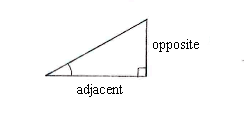Solution 4.2:2a
From Förberedande kurs i matematik 1
(Difference between revisions)
m |
|||
| Line 1: | Line 1: | ||
The opposite and adjacent are given in the right-angled triangle and this means that the value of the tangent for the angle can be determined as the quotient between the opposite and the adjacent: | The opposite and adjacent are given in the right-angled triangle and this means that the value of the tangent for the angle can be determined as the quotient between the opposite and the adjacent: | ||
| + | {| width="100%" | ||
| + | | width="50%" align="center"|<math>\tan v = 2/5</math> | ||
| + | | width="50%" align="left"|[[Image:4_2_2_a.gif]] | ||
| + | |} | ||
| - | + | At the same time, this is a trigonometric equation for the angle ''v''. | |
| - | + | Note: In the chapter on "Trigonometric equations", we will investigate more closely how to solve equations of this type. | |
| - | + | ||
| - | + | ||
| - | + | ||
| - | + | ||
| - | + | ||
Current revision
The opposite and adjacent are given in the right-angled triangle and this means that the value of the tangent for the angle can be determined as the quotient between the opposite and the adjacent:
| \displaystyle \tan v = 2/5 | 
|
At the same time, this is a trigonometric equation for the angle v.
Note: In the chapter on "Trigonometric equations", we will investigate more closely how to solve equations of this type.
